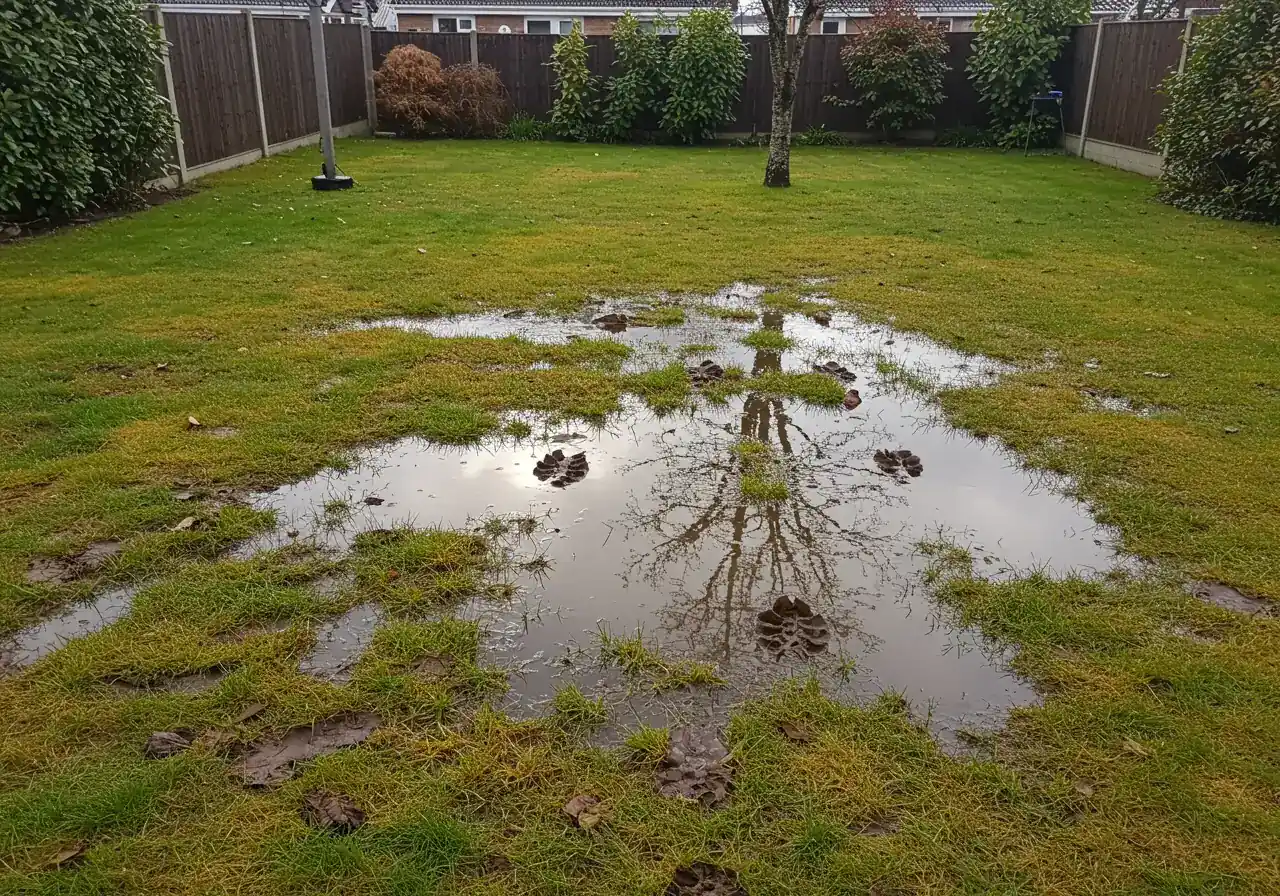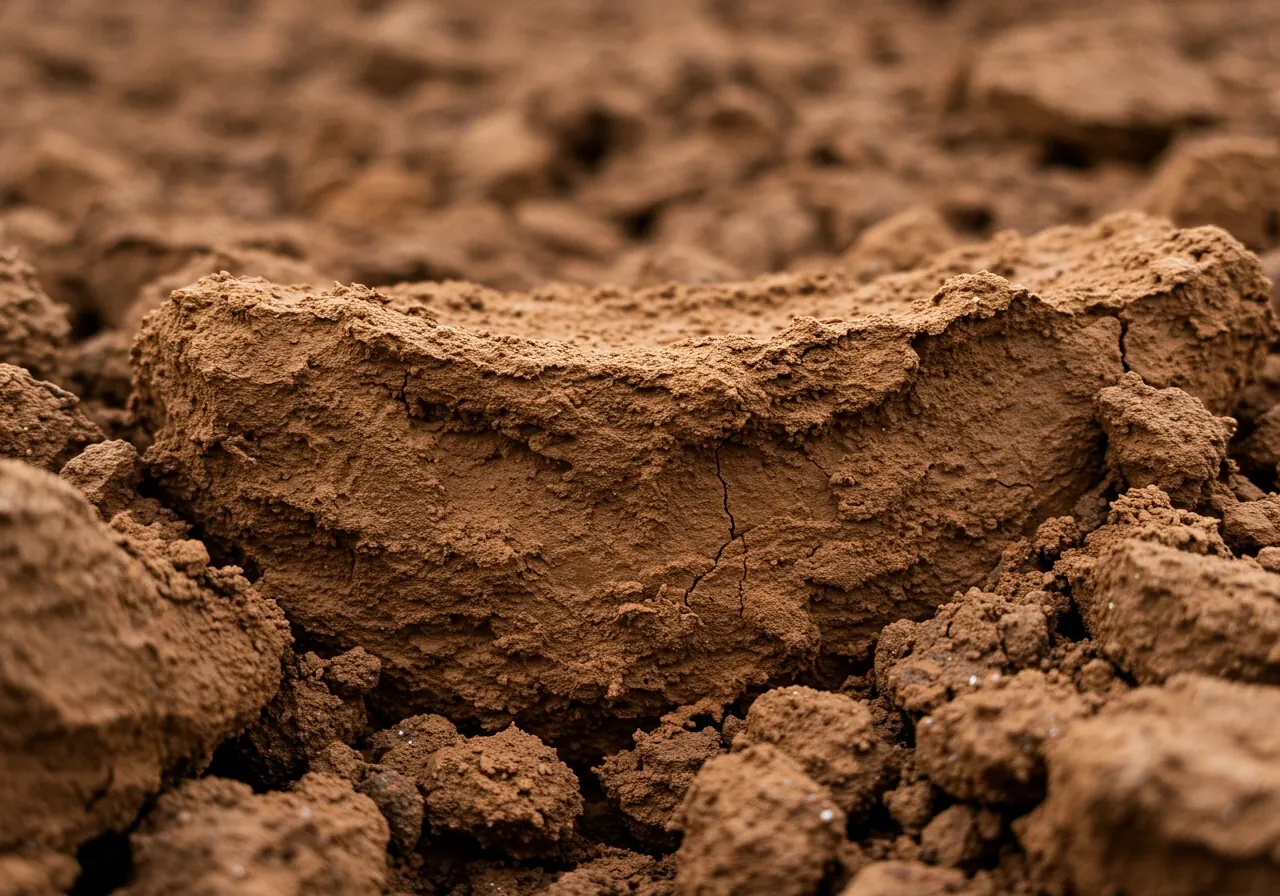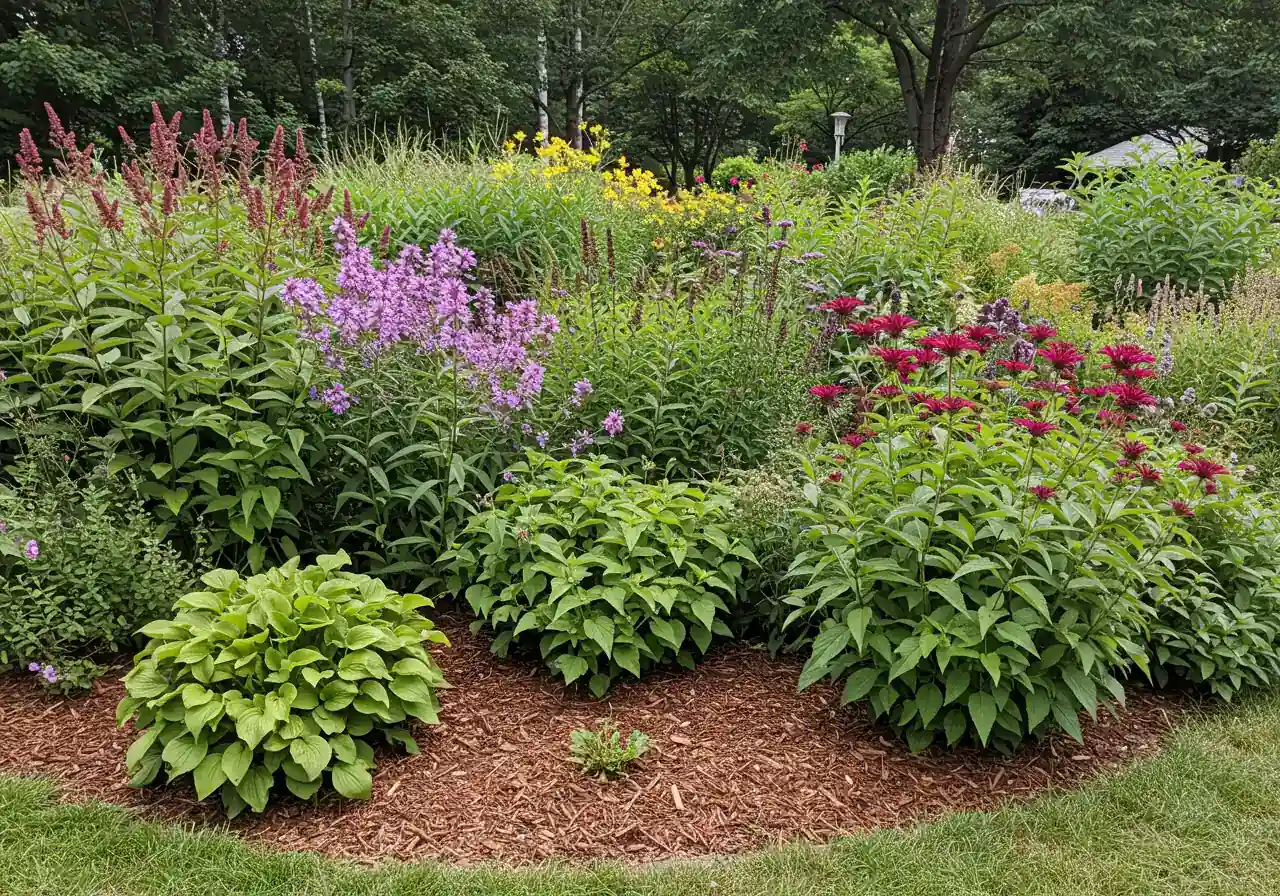Metcalfe Rain Gardens: Solve Clay Soil Drainage Issues
Quick Summary
- Heavy clay soil common in Metcalfe and Ottawa causes poor lawn drainage and soggy spots.
- Rain gardens are shallow, landscaped depressions designed to collect and absorb stormwater runoff.
- They improve drainage, filter pollutants, reduce lawn maintenance, and create beautiful habitat.
- Proper site selection, soil amendment (mixing clay with sand/compost), and plant choice (water-tolerant natives) are key to success.
- Building a rain garden is a manageable DIY project or can be professionally installed.
Experiencing drainage issues? Request a free quote for professional landscaping solutions today!
Introduction: Soggy Lawn Got You Down in Metcalfe? Rain Gardens to the Rescue!

Is your Metcalfe lawn feeling more like a Metcalfe marsh after every rainfall? Do you dread mowing because you need rubber boots just to cross the yard, maybe waving hello to neighbours in nearby Osgoode or Greely who share your soggy struggle? You're not alone! Many of us in the wider Ottawa region battle heavy clay soil. It’s fantastic for holding onto nutrients, but less fantastic when it comes to drainage, leading to puddles and squishy spots that overstay their welcome.
But don't despair and start researching pontoon boats just yet! There's a beautiful, practical, and surprisingly effective landscaping solution: the mighty rain garden. Imagine transforming that perpetually damp patch into a stunning garden feature, thriving with attractive native plants specifically chosen because they love soaking up extra water. Rain gardens are designed to naturally manage stormwater runoff, significantly improving your yard's drainage, reducing lawn maintenance headaches, and creating lovely sustainable landscaping. Ready to trade the swampy sighs for garden delight? Let's dig into how a rain garden can be your yard's hero!
The Clay Conundrum: Why Drainage is Such a Headache from Greely to Manotick
Okay, let's dig into the dirt, literally!

The Clay Conundrum: Why Drainage is Such a Headache from Greely to Manotick
Ever feel like your backyard from Greely all the way down to Manotick turns into a wading pool after a decent Ottawa downpour? You're not imagining things, and you're definitely not alone. The culprit is usually hiding right under your feet: good old clay soil. While fantastic for making pottery, it can be a real pain for gardening and lawn drainage.
So, what’s the deal with clay? Imagine tiny, tiny flat plates, much smaller than grains of sand or silt. That's kind of what clay particles are like. When they get wet, they stick together really tightly, leaving hardly any space for water (or air!) to move through. Think of it like a stack of wet dinner plates versus a jar full of marbles. Water flows easily through the marbles (like sandy soil), but it gets stuck on top of the stacked plates (hello, clay!).
Now, add in our classic Ottawa weather cycle. We get freezing winters followed by spring thaws and sometimes heavy summer rains. This freeze-thaw action and the weight of snow or standing water can compact the clay even more, squishing those tiny particles closer together. It's like the soil throws a tiny tantrum and refuses to let anything pass through! The result? Puddles that linger, soggy lawns that are impossible to mow without leaving muddy tracks, and unhappy plant roots that can literally drown or develop root rot because they can't get the oxygen they need. It makes typical landscaping tasks feel like wrestling matches.
But don't throw in the trowel just yet! Understanding the problem is the first step. While changing your soil's fundamental nature is a big job, you can improve things. Adding organic matter like compost over time helps separate those sticky clay particles. Applying mulch correctly is also a huge help for soil health – you can learn more with these Metcalfe Mulch Magic: Expert Installation Tips. Making sure your yard is prepped before winter can also prevent some compaction issues; consider how Comprehensive Fall Cleanup Services for Metcalfe Yards can set your lawn up for a better spring.
Working with heavy clay often means choosing the right plants that don't mind "wet feet" occasionally, or building raised beds. And believe us, tackling heavy clay requires robust equipment, so keeping your tools in shape is key – check out tips to Prep Your Metcalfe Garden Tools for Winter: Rust Prevention Tips. Sometimes, strategic planting can even help manage moisture, which ties into understanding your yard's specific conditions, like those discussed in Creating Summer Microclimates & Wind Protection in Metcalfe Gardens.
If the clay conundrum feels overwhelming, remember there are solutions, from amending the soil to creating specialized features like rain gardens, or getting professional help. Feel free to Explore Our Landscaping Services if you'd like a hand turning that soggy spot into a beautiful, functional part of your yard. Clay soil is a challenge, but it's one we can definitely manage with the right approach! Check out our work on Google to see how we tackle local landscaping challenges.
What in the World is a Rain Garden (and Why Your Yard Needs One)?

Alright, let's talk about rain gardens! The name sounds lovely, maybe a bit magical, but what exactly is one? Think of it as a superhero for your soggy yard spots, disguised as a beautiful garden feature. Essentially, a rain garden is a shallow, bowl-shaped garden bed, cleverly designed and landscaped to catch rainwater runoff from surfaces like your roof, driveway, or even parts of your lawn. It's not a pond – the goal isn't to hold water constantly, but rather to let it soak into the ground slowly, usually within a day or two.
So, how does this magic work? It’s less magic, more smart gardening! When rain hits your property, instead of pooling on the lawn or rushing straight into the storm drain (carrying pollutants with it), it's directed towards your rain garden. The garden itself is built with layers – typically some amended soil that drains well, topped with mulch. Then, it's planted with specific types of hardy, deep-rooted plants, often beautiful native plants, that absolutely adore getting their feet wet occasionally but can also handle drier periods. These plants and the special soil act like a natural sponge and filter. They soak up the excess water, allowing it to slowly seep into the ground, filtering out stuff like lawn chemicals or oils from the driveway along the way. This is quite different from a traditional French drain or pipe, which just moves water away quickly without providing these filtering benefits. Find more info on sustainable practices from the Rideau Valley Conservation Authority.
Now, the "why you need one" part! The benefits are fantastic, especially for homeowners in Ottawa areas like Barrhaven or Nepean dealing with varied drainage challenges. First off, it tackles those annoying puddles and soggy patches, improving your yard's overall usability. No more squish-squash when you walk across the lawn after rain! Secondly, it's incredibly eco-friendly. By capturing and filtering stormwater runoff, you're helping to keep local waterways cleaner and reducing the burden on municipal storm systems. The City of Ottawa encourages such efforts. It’s a small action with a positive ripple effect! Thirdly, they look great! A well-designed rain garden adds colour, texture, and visual interest to your landscaping, attracting pollinators like butterflies and bees, plus birds. It’s way more attractive than a muddy patch or a bare drain grate. Check our gallery for inspiration. Finally, while they need care during setup and establishment (like keeping weeds at bay), mature rain gardens featuring native plants can often require less fuss than a traditional lawn care area.
Setting up a rain garden involves some planning regarding location, size, and plant selection. It's a fantastic DIY project if you're feeling adventurous, but it can also be part of a larger property overhaul. If you're considering upgrading several areas, perhaps combining a rain garden project with refreshing other spots using professional sod installation, getting professional advice is a good idea. Tackling the initial prep work is key; sometimes a thorough cleanup, like the kind offered by our Ottawa property cleanup service, is the best first step. For residents a bit further out, we even provide specific help such as our Marionville yard cleanup service. Explore all our yard care options to see how we can help, and remember you can always manage your services online through our convenient portal. A rain garden might just be the beautiful, practical solution your yard has been waiting for!
Key Rain Garden Advantages
- Improved Drainage: Directly addresses pooling water and soggy areas.
- Water Filtration: Naturally cleans runoff before it enters groundwater or storm sewers.
- Enhanced Beauty: Adds visual interest with diverse plants and textures. Check out our transformations page for ideas.
- Habitat Creation: Attracts beneficial insects, pollinators, and birds.
- Reduced Mowing: Replaces lawn area with less demanding garden space.
- Eco-Friendly: Sustainable approach to stormwater management.
Understanding Planting Zones in a Rain Garden
Rain gardens have micro-zones based on how wet they get:
- Zone 1 (Base): The lowest, wettest area. Plants here must tolerate standing water for 24-48 hours (e.g., Blue Flag Iris, Joe Pye Weed).
- Zone 2 (Slopes): Middle area, gets moist but drains faster. Plants tolerate occasional wet feet but also average conditions (e.g., Bee Balm, Switchgrass).
- Zone 3 (Edge/Berm): The highest, driest area. Plants here prefer average to slightly moist soil and must tolerate drier periods (e.g., Black-Eyed Susan, Little Bluestem).
Choosing plants suited for each zone is vital for a thriving garden. Consider our garden installation services for expert plant selection.
Rain Garden Maintenance
Compared to a traditional lawn requiring regular mowing and care, established rain gardens are relatively low-maintenance.
- Year 1-2: Regular watering (especially during dry spells) and diligent weeding are crucial for establishment.
- Ongoing: Annual spring cleanup (removing debris, trimming dead stems), occasional weeding, and topping up mulch every 1-2 years are the main tasks.
- Minimal Fertilizing: Usually not required if amended soil and native plants are used.
For help keeping your garden looking its best, explore our garden maintenance options.
Designing Your Dream Rain Garden: Ottawa-Specific Considerations
Alright, you're sold on the idea of a rain garden – fantastic! Now for the fun part: designing it. Creating a rain garden that thrives in our Ottawa climate and tackles that pesky drainage issue isn't overly complicated, but paying attention to a few key details specific to our region will make all the difference. Think of it as giving your garden a superhero cape and a custom-tailored suit. Let's dive into the design nitty-gritty!
1. Finding the Sweet Spot: Site Selection
Choosing the right location is job number one. You need your rain garden where it can actually intercept stormwater runoff.
- Follow the Flow: Look for where water naturally pools or flows after a rain shower. Areas downhill from downspouts (redirected, of course!), driveways, or sloping parts of your lawn are prime candidates.
- Safety First: Keep the garden at least 3 metres (about 10 feet) away from your house foundation. We want the water soaking down, not sideways into your basement! Also, stay clear of septic systems/leach fields and underground utility lines (call or click before you dig! Visit Ontario One Call).
- Sunlight Matters: Most rain garden plants prefer full sun to partial shade. Observe the potential spot throughout the day to see how much light it gets. This will influence your plant choices later.
- Neighbourly Considerations: Be mindful of property lines and our terms and conditions regarding work boundaries. While your garden helps the environment, ensure it won't cause water issues for your neighbours. A little planning prevents headaches later.
2. Size and Shape: Keep it Simple!
Don't let sizing stress you out. Fancy calculations exist, but for most home gardens in areas like Richmond or Metcalfe, a simpler approach works well.
- Rule of Thumb: Aim for your rain garden to be roughly 10-20% of the size of the hard surface area draining into it (e.g., the section of roof feeding that downspout, or the part of the driveway).
- Shallow Does It: Rain gardens aren't ponds. A gentle depression, typically 15-30 cm (6-12 inches) deep at the lowest point, is usually perfect. The goal is for water to soak in within 24-48 hours.
- Shape Up: Get creative! Rain gardens don't need to be perfect circles. Free-form, kidney bean shapes, or long, flowing swales often look more natural and blend better with your existing landscaping. Design a shape that fits your space and aesthetic. See some examples in our project gallery.
Typical Rain Garden Soil Composition
Approximate ratios for amending heavy clay soil. Adjust based on existing soil conditions.
3. The Soil Solution: Tackling Ottawa Clay
This is mission-critical for success in our region! That heavy clay soil needs a serious upgrade to improve drainage. Simply digging a hole and planting won't cut it – you'll just create a clay bowl bathtub.
- Dig Out: Excavate the area to your planned depth.
- Amend, Amend, Amend: The magic mix usually involves blending some of the excavated soil (if it's not too heavy, maybe 30-50%) with coarse sand (like construction sand, about 30-40%) and generous amounts of compost (20-40%). This creates a porous, fertile mix that drains well but holds enough moisture. Getting the ratios right is important; if you need guidance choosing the best components, we offer help with material selection. Proper soil preparation is essential.
- Top it Off: Finish with a layer of organic mulch (like shredded bark, not rock). Mulch helps retain moisture between rains, suppresses weeds, and adds a finished look. Our mulching services ensure a professional finish.
4. Plant Power: Choosing Zone 5 Champions
Now pick your players! We need plants that are hardy for Ottawa's Zone 5 winters and can handle both periodic sogginess and potential summer dry spells.
- Native is Often Best: Native plants are adapted to our local conditions and support local wildlife. Learn more from organizations like Fletcher Wildlife Garden.
- Water Tolerance: Look for perennials, grasses, and shrubs labelled as tolerant of "wet feet" or "moist soil," but also reasonably drought-tolerant once established.
- Placement Strategy: Put the most water-loving plants in the lowest part of the garden and those that prefer slightly drier conditions along the sloped sides or berm.
- Ottawa Favourites: Consider plants like Joe Pye Weed, various Dogwood shrubs, Serviceberry, Blue Flag Iris, Switchgrass, Ostrich Ferns, and Bee Balm. Check plant tags for specific light and moisture needs.
Building a rain garden is a fantastic investment in your property's beauty and function. It might seem like a bit of work upfront, perhaps even prompting a larger yard refresh that includes installing new sod around your new feature, but the results are well worth it. Once established, your rain garden will need some basic tending, similar to any garden bed; if you find yourself short on time, options for ongoing garden care are available. Always remember to review project details and expectations; you can check our service terms online. We love seeing homeowners embrace greener solutions – feel free to send us a quick thank you note or even pictures once your beautiful, water-wise garden is blooming!
Let's Get Digging! A (Relatively) Simple Guide to Building Your Rain Garden
Okay, enough talk about soggy lawns – let's grab a shovel and make something beautiful! Building your own rain garden is totally doable, and hey, think of the bragging rights. It's a fantastic landscaping project that pays you back with better drainage and lovely views. Here’s a (relatively) simple guide to get you started:
Step 1: Safety First
Before digging, contact Ontario One Call to locate utilities. Mark your garden shape, ensuring it's 3m+ from your foundation.
Step 2: The Big Dig
Excavate a shallow bowl (15-30cm deep) with gentle slopes. Pile soil on a tarp nearby.
Step 3: Soil Superhero Training
Mix native soil (30-50%), coarse sand (30-40%), and compost (20-40%). Refill the excavation with this amended mix. Need supplies? Check material selection.
Step 4: Plant Power!
Arrange chosen plants according to water tolerance (wettest in center). Follow spacing guides. Consider our garden install service for planting help.
Step 5: Mulch & Water In
Apply 5-7cm of organic mulch (like shredded bark). Water thoroughly to settle soil and plants. Proper mulching is key.
Step 6: Tender Loving Care
Water regularly during the first season. Weed promptly. Ongoing care can be managed with garden maintenance services.
Know When to Call for Backup: While this guide covers the basics, some situations might warrant calling in the pros. If your site has very steep slopes, extremely compacted soil (like you might find in parts of Kars or Winchester after construction), or if the digging just feels overwhelming, don't hesitate. Sometimes, significant landscaping projects benefit from professional site prep; you might need extensive yard preparation, maybe similar to our Marionville property cleanup service or even getting professional site prep like our Metcalfe property cleanup service if the area needs major clearing first. Professionals like those at Clean Yards can ensure proper grading and soil amendment for optimal drainage.
There you have it! With a bit of planning and elbow grease, you can transform a soggy spot into a thriving, functional, and beautiful rain garden. Happy digging!
Keeping Your Rain Garden Happy: Year-Round Care in Ottawa
So, you've got a gorgeous rain garden soaking up those pesky puddles – high five! Now, you might be wondering if it needs constant pampering. Good news! Once established, rain gardens are surprisingly low-maintenance landscaping features, especially compared to a thirsty lawn. Think of it less like a demanding diva and more like a helpful, hardy friend. Here’s a seasonal guide to keeping your Ottawa rain garden thriving, contributing to the beauty of neighbourhoods from Barrhaven to Russell.
Spring Spruce-Up (April-May):
As the snow melts (finally!), it's time for a gentle wake-up call.
- Clean Out Crew: Remove any accumulated winter debris – leaves, twigs, maybe that rogue mitten. Check where water flows into the garden (the inflow) and make sure it's clear. A thorough spring refresh, perhaps with help from an Ottawa garden clean up service, sets the stage for healthy growth.
- Plant Check: See how your native plants, perennials, and shrubs weathered the winter. Trim away any dead or damaged stems. If any plants didn't make it (it happens!), spring is a good time to add replacements. Getting things right from the start helps minimize future issues; sometimes problems stem from the initial setup, making a professional garden installation phase valuable.
- Mulch Makeover: Check your mulch depth. Aim for about 5-7 cm (2-3 inches). Top it up if needed to help suppress weeds and retain moisture for the warmer months ahead.
Summer Simplicity (June-August):
Your rain garden should be hitting its stride now.
- Weed Patrol: Keep an eye out for unwanted guests (weeds!) and pull them promptly before they get established, especially in the first couple of years. A good layer of mulch really helps here.
- Water Wisely: Established rain gardens with deep-rooted native plants are designed to handle Ottawa's typical rainfall and drier spells. You generally only need to water during prolonged droughts (like several weeks with no significant rain). Let nature do most of the work!
- Observe Flow: After a heavy rain, check if water is pooling for longer than 48 hours. If so, your drainage might need a slight adjustment, possibly due to soil compaction.
Fall Tidy-Up (September-November):
Time to prep for the colder months.
- Leaf Relief: Keep the inflow clear of falling leaves to prevent clogs. You can leave some plant stems and seed heads standing over winter – they provide visual interest and food/habitat for birds and beneficial insects. Avoid cutting everything down flat. Need help with leaves? See our fall cleanup services.
- Final Weed Sweep: Do one last check for weeds.
- Mulch Check (Again): Ensure your mulch layer is still adequate to protect the soil over winter. If you need a hand with the bigger tasks, remember that help is available across the region, even if you need assistance with garden tidying similar to our Marionville garden clean up service.
Winter Rest (December-March):
Let it snow!
- Hands Off: Your rain garden is dormant. Minimal care is needed. Enjoy the structural beauty of the grasses and stems against the snow.
- Salt Alert: If your garden is near a road or walkway that gets salted, keep an eye out for potential salt damage in the spring. Consider salt-tolerant plants for those edges if it becomes an issue.
The Low-Maintenance Dream: Remember, the goal is a beautiful, functional garden that reduces your yard work. Choosing hardy, appropriate plants and maintaining a good mulch layer are key. You’re managing stormwater runoff ecologically, creating habitat, and adding beauty – it’s a win-win-win! Watching your rain garden mature is one of the most rewarding parts, contributing positively to your property and community aesthetics in areas like Embrun. You can see similar satisfying landscaping transformations that boost curb appeal and enjoyment.
Quick Care Checklist
| Season | Key Tasks |
|---|---|
| Spring | Clean debris, check inflow, inspect plants, trim dead growth, top up mulch. |
| Summer | Weed as needed, water only in severe drought, check drainage after heavy rain. |
| Fall | Clear inflow of leaves, final weed check, optional partial plant cutback, check mulch. Consider Metcalfe property cleanup services for major tidying. |
| Winter | Relax, monitor for salt damage near edges. |
Rain Garden Quick Tips for Ottawa Homeowners
Ready to ditch the puddles and boost your curb appeal? Keep these quick pointers in mind for rain garden success right here in Ottawa!
- Soil is THE Secret: Seriously, don't just dig a hole in that infamous Ottawa clay and hope for the best – you'll make a bathtub! Amending the soil with compost and sand is the most crucial step for good drainage. If the spot needs serious clearing first, getting help from a professional Metcalfe yard cleanup service can make starting less of a headache.
- Location, Location, Safety: Remember the golden rule: keep your rain garden at least 3 metres (that's about 10 feet) away from your house foundation. We want water soaking down, not sideways into your basement!
- Water Baby Steps: Even though it’s designed for rain, your new rain garden needs regular watering for its first season, especially during dry spells in areas like Barrhaven. Give those native plants time to settle in. Need a hand keeping weeds down or tidying up later? A Metcalfe garden clean up service can definitely help maintain its beauty.
Feeling like it's part of a bigger landscaping project or need a major overhaul before starting? A comprehensive Ottawa yard cleanup service can prep the entire area. If you're unsure where to begin, feel free to book an estimate to discuss the possibilities! We respect your privacy policy.
FAQs: Your Metcalfe & Ottawa Rain Garden Questions Answered
Usually, no permit is needed for a standard residential rain garden on your own property, especially in areas like Vernon or Metcalfe. However, it’s always wise to double-check current City of Ottawa bylaws, particularly if your plan involves significant landscaping changes, redirects water near property lines, or is close to municipal infrastructure. If your project feels complex, feel free to get in touch with us for advice.
Absolutely not, unless something's gone wrong! A properly designed rain garden improves drainage and only holds water for about 24-48 hours after rainfall – much faster than the mosquito breeding cycle (which takes 7-12 days). If water lingers longer, it usually means the soil needs better amendment or the size needs adjusting. Think beautiful garden feature, not permanent puddle!
Great news! Once established (after the first year or two), rain gardens are surprisingly low-maintenance compared to lawns. Your main jobs will be occasional weeding (especially early on), topping up the mulch every year or two, and a quick spring cleanup. If general yard tidiness feels overwhelming, remember services like professional property clean up can handle the broader upkeep around your lovely new feature.
Yes, you can! Even on flat ground, you create the necessary shallow depression by excavating. You can use the removed soil to build a gentle berm (a small raised edge) around parts of the garden to help contain the stormwater runoff. The key is ensuring the base has excellent drainage through proper soil preparation and amendment techniques, creating that crucial slight depth difference for water to collect temporarily.
While native plants are highly recommended because they're perfectly adapted to Ottawa's climate and support local wildlife, you can use other hardy perennials and shrubs. The crucial factor is choosing plants tolerant of both temporary wet feet and potential dry spells. Look for Zone 5 hardy varieties that fit these "moist-to-average" soil conditions for best results in your gardening efforts. Explore options with our garden maintenance team.
Costs vary quite a bit! A DIY project mainly involves buying soil amendments (compost, sand), plants, and mulch. Professional installation adds labour costs but ensures correct construction. It's often more affordable than complex underground drainage systems. We encourage homeowners to share their budget thoughts when requesting quotes; you can even provide feedback on estimates you receive to help ensure the project aligns with your expectations.
Conclusion: Turn Your Soggy Spot into a Beautiful Solution
So, there you have it! That soggy spot in your Metcalfe yard doesn't have to be a muddy monster under your boots anymore. We've dug into why Ottawa's notorious clay soil often leads to drainage dramas, turning lovely lawns into temporary ponds. But the brilliant solution? The mighty rain garden – a clever piece of landscaping that transforms problem puddles into beautiful, functional planting beds. By creating these shallow depressions with improved soil and delightful, water-loving native plants, you're not just fixing a soggy patch. You're actively managing stormwater runoff, reducing pollution, attracting pollinators, and seriously boosting your home's curb appeal. It's smart, sustainable gardening that works wonders from Metcalfe to Barrhaven. Trading the squish for something stunning is easier than you might think!
Ready to take the plunge?
- Get inspired! Start sketching out ideas for your own DIY rain garden transformation. Visit our gallery for ideas.
- Need a hand? Contact us today to discuss professional rain garden design and installation tailored to your yard.
- Curious about more? Explore our full range of landscaping and property care services to create your dream outdoor space, whether you need help in Metcalfe, Marionville, or greater Ottawa. Learn more about us and our commitment to quality.

